Related Resources

Document
Fire Forensics: Student Guide

This video shows a fuel-controlled fire with no limitation of oxygen. Note the four stages of fire:
Some fuels will leave behind evidence such as char, ash, or other chemicals.